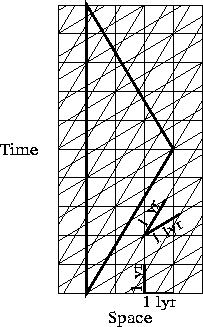1. Scalar spacetime distance
Frame B (primed) moves at speed v relative to frame A (unprimed). Show that the scalar spacetime interval
| s2 = t2 - r2 | (1.1) |
2. Twin Paradox
Your twin leaves you on Earth and travels to the spacestation Alpha,
![]() = 3 lyr away,
at a good fraction of the speed of light,
then immediately returns to Earth at the same speed.
The accompanying spacetime diagram shows the
corresponding worldlines of both you and your twin.
Aside from part (a) and the first part of (b),
I want you to derive your answers mathematically,
using logic and Lorentz transformations.
However, the diagram is accurately drawn,
and you should be able to check your answers by measuring.
Note: read the question! Each part contains several subparts.
= 3 lyr away,
at a good fraction of the speed of light,
then immediately returns to Earth at the same speed.
The accompanying spacetime diagram shows the
corresponding worldlines of both you and your twin.
Aside from part (a) and the first part of (b),
I want you to derive your answers mathematically,
using logic and Lorentz transformations.
However, the diagram is accurately drawn,
and you should be able to check your answers by measuring.
Note: read the question! Each part contains several subparts.
 Press here to download PostScript copy (23K) of spacetime diagram.
Press here to download PostScript copy (23K) of spacetime diagram.
(a) Label the worldlines of you and your twin. Draw the worldline of a light signal which travels from you on Earth, hits Alpha just when your twin arrives, and immediately returns to Earth. Draw the twin's ``now'' when just arriving at Alpha, and the twin's ``now'' just departing from Alpha (in the first case the twin is moving toward Alpha, while in the second case the twin is moving back toward Earth).
(b)
From the diagram, measure the twin's speed v relative to you,
in units where the speed of light is unity, c = 1.
Deduce the Lorentz gamma factor ![]() ,and the redshift factor 1 + z,
in the cases
(i) where the twin is receding,
and (ii) where the twin is approaching.
,and the redshift factor 1 + z,
in the cases
(i) where the twin is receding,
and (ii) where the twin is approaching.
(c)
Choose the spacetime origin to be the event where the twin leaves Earth.
Argue that the position 4-vector of the twin on arrival at Alpha is
 |
(2.1) |
(d)
How much do you and your twin age respectively
during the round trip to Alpha and back?
What is the ratio of these ages?
Express your answers first in terms of ![]() , v, and
, v, and ![]() ,and then in years.
,and then in years.
(e)
What is the distance between the Earth and Alpha from the twin's point
of view?
What is the ratio of this distance to the distance between Earth and
Alpha from your point of view?
Explain how your arrived at your result.
Express your answer first in terms of ![]() , v, and
, v, and ![]() ,and then in years.
,and then in years.
(f)
You watch your twin through a telescope.
How much time do you see (through the telescope)
elapse on your twin's wristwatch between launch and arrival on Alpha?
How much time passes on your own wristwatch during this time?
What is the ratio of these two times?
Express your answers first in terms of ![]() , v, and
, v, and ![]() ,and then in years.
,and then in years.
(g)
On arrival at Alpha,
your twin looks back through a telescope at your wristwatch.
How much time does your twin see (through the telescope)
has elapsed since launch on your watch?
How much time has elapsed on the twin's own wristwatch during this time?
What is the ratio of these two times?
Express your answers first in terms of ![]() , v, and
, v, and ![]() ,and then in years.
,and then in years.
(h)
You continue to watch your twin through a telescope.
How much time elapses on your twin's wristwatch,
as seen by you through the telescope,
during the twin's journey back from Alpha to Earth?
How much time passes on your own watch as you watch
(through the telescope) the twin journey back from Alpha to Earth?
What is the ratio of these two times?
Express your answers first in terms of ![]() , v, and
, v, and ![]() ,and then in years.
,and then in years.
(i)
During the journey back from Alpha to Earth,
your twin likewise continues to look through a telescope at the time registered
on your watch.
How much time passes on your wristwatch,
as seen by your twin through the telescope, during the journey back?
How much time passes on the twin's wristwatch from the twin's point of view
during the journey back?
What is the ratio of these two times?
Express your answers first in terms of ![]() , v, and
, v, and ![]() ,and then in years.
,and then in years.
3. Tachyons
B recedes at velocity v from A. A sends a tachyon (faster-than-light) signal to B at speed u > 1 in A's frame. On receipt of the tachyon, B immediately returns a tachyon signal to A at speed u > 1 in B's frame (note u in B's frame is not the same as u in A's frame). Draw a spacetime diagram of the situation. Show that if u exceeds a certain critical speed, then the tachyonic signal may return to A before A emits it. What is the speed u in terms of v? What conclusion can you draw from this thought experiment?